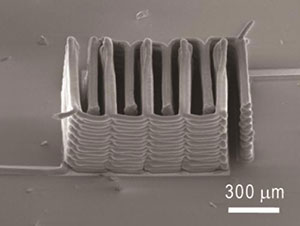Batteries – those oft vital, oft overlooked items that power many facets of the electronically-driven lifestyles that many of us have succumbed to. And batteries are the latest “thing” undergoing research, in a 3D printed context, specifically by a combined team from the Wyss Institute at Harvard University and the University of Illinois at Urbana-Champaign. Both of these institutes have a demonstrated track record in 3D printing research and most recently this team has revealed a successful research project that shows how a customized 3D printer can be used to print micro sized lithium-ion batteries.
These batteries are not necessarily what you and I would recognize as batteries — each one being about the size of a grain of sand — but they are being developed to fulfill the purpose of supplying power to tiny devices in fields such as medicine or communications. To date, many miniature devices often require batteries that are much larger than the devices themselves — kind of negating the miniaturization advantages is one go. This new research, with a host of potential applications, aims to overcome this issue.
Practically speaking, the research project has developed a method for printing precisely interlaced stacks of tiny battery electrodes, whereby each measures less than the width of a human hair. The theory behind this is that more energy can be contained in a much smaller space by creating stacks of tightly interlaced, ultra-thin electrodes that were built out of plane. This has been enabled by customizing 3D printing technology at the micro scale and developing specialized materials specifically for the application. The function of the materials was critical as they had to be electrochemically active in order to produce working anodes and cathodes.

Jennifer Lewis is also the Hansjörg Wyss Professor of Biologically Inspired Engineering at the Harvard School of Engineering and Applied Sciences (SEAS), and a Core Faculty Member of the Wyss Institute for Biologically Inspired Engineering at Harvard University and led the project in her prior position at the University of Illinois at Urbana-Champaign, in collaboration with co-author Shen Dillon, an Assistant Professor of Materials Science and Engineering.
Dillon explains the success of the research: “The electrochemical performance [of the 3D printed batteries] is comparable to commercial batteries in terms of charge and discharge rate, cycle life and energy densities. We’re just able to achieve this on a much smaller scale.”
While Donald Ingber, Wyss Founding Director, paid tribute to Lewis’ pioneering work: “Jennifer’s innovative microbattery ink designs dramatically expand the practical uses of 3D printing, and simultaneously open up entirely new possibilities for miniaturization of all types of devices, both medical and non-medical. It’s tremendously exciting.”
The video below provides some context of the miniaturization and the sizes we’re dealing with here. It show the minute 3D printer nozzle laying down the specially formulated material.
Source: PhysOrg
Video Credit: Teng-Sing Wei, Bok Yeop Ahn, Jennifer Lewis


